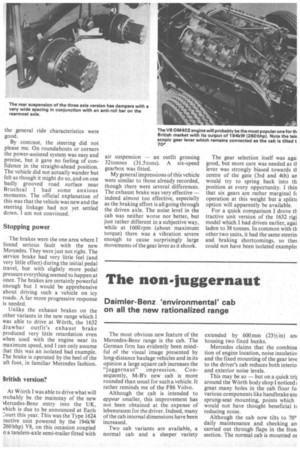The non-juggernaut
Page 47

Page 48

If you've noticed an error in this article please click here to report it so we can fix it.
Daimler-Benz 'environmental' cab on all the new rationalized range
The most obvious new feature of the Mercedes-Benz range is the cab. The German firm has evidently been mindful of the visual image presented by long-distance haulage vehicles and in its opinion a large square cab increases the "juggernaut" impression. Consequently, M-B's new •cab is more rounded than usual for such a vehicle. It rather reminds rue of the F86 Volvo.
Although the cab is intended to appear smaller, this improvement has not been obtained at the expense of lebensraum for the driver. Indeed, many of the cab internal dimensions have been increased.
Two cab variants are available, a normal cab and a sleeper variety extended by 600 mm (231/2 in) an housing two fixed bunks.
Mercedes claims that the combina tion of engine location, noise insulatioi and the fixed mounting of the gear leve to the driver's cab reduces both interio and exterior noise levels.
This may be so — but on a quick trij around the Wirth body shop I noticed ; great many holes in the cab floor fo various components like handbrake anc sprung-seat mounting, points which would not have thought beneficial n reducing noise.
Although the cab now tilts to 70° daily maintenance and checking an carried out through flaps in the fron section. The normal cab is mounted or o torsion bearings with rubber bushes the front and damped spring struts at rear.
The layout for the sleeper cab is sometat different, with two bent Ushaped rings and a transverse stabilizer at the int and a transverse leaf-spring at the is and shock absorbers at each corner. The power units for the new range, -eady familiar on the Continent but ;s well known in the UK, consist of six, :ht and 10-cylinder options, all in vee rmation. They were all designed on a odular principle in order to employ as any common parts as possible.
What this means in effect is that the .gines are constructed from a number vee-twins developing 24kW (32 bhp) cylinder.
The new series ranges from the V-6 of 13kW DIN ( 192 bhp) output through e V-8 and V-10 to the V-12 which welops 321 kW DIN (430 bhp). All ese maximum outputs are produced at 500 rev./ min.
Rather surprisingly, in view of some its comments in the past, Mercedes ys that the engine range has enough built thermal and mechanical reserves enable pressure charging to be used ithout problems. The output could en be extended in the case of the V-12, s example, to around 450kW 00 bhp) without the need for charge ioling. With increased pressure ratios id charge cooling, maximum outputs the region of 638kW (850 bhp) are aimed. Now that would give an interting performance at 32 tons rating. Great efforts have obviously been ade on emission control and it is aimed that all the engines can meet, ithout modification, the Californian nission standards for 1976 with regard hydrocarbons and oxides of nitrogen
Transmission variety
By ringing the changes on its various components Mercedes can offer gearboxes with from six to 18 speeds. ZF gearboxes are used and the two test vehicles that I tried were equipped with an eight-speed range-change unit and a six-speed box respectively.
The new axle series is divided into two categories, dependent on load carrying capacity — the lighter range of 10 to 12 tonnes and the heavier one of 13 to 16 tonnes. The two classes feature two different differential assemblies with a crown wheel diameter of 233mm (9 in) for outputs up to 194kW (260 bhp) and up to 32 tonnes combination weight, and 300mm (111/2 in) for outputs up to 300kW (400 bhp) and gross weights of around 50 tonnes.
Tapered frame
In designing the chassis for the new range great attention has been made to limit the number of pressings required while not restricting the wheelbase variants available. In order to keep the vehicle height as low as possible a fishbelly form is used with tapered frame ends.
The modular unit construction principle was again used in the design of the presses and punches for the sidemembers. The number of wheelbase • variants is achieved simply by adding extension pieces of different lengths in the middle section. With cross-members and spring brackets, the front section is the same for all vehicles in the heavyduty truck range. The frame height of 300 mm (111/2 in) and the frame width of 900 mm (341/2in) (front) and 760mm (00 in) (rear) are standard for twoand three-axle trucks. The metal thickness varies according to tonnage from 7.5 to 8.5mm (0.3 to 0.34 in).
Soft suspension
A new type of pivoting suspension, introduced for the three-axle trucks, uses a long, pivoted spring in conjunction with wide-spaced dampers and an anti-roll bar on the rear axle. On the two-axle models two-phase leaf springs at the rear are standard and with the exception of the 19-tonners they all have dampers on the rear axle.
As the new range of vehicles comprises 76 variations of truck a complete technical data sheet would be almost impossible to produce. The three models here include the types that I personally tested and are representative of the complete range.




































































































































